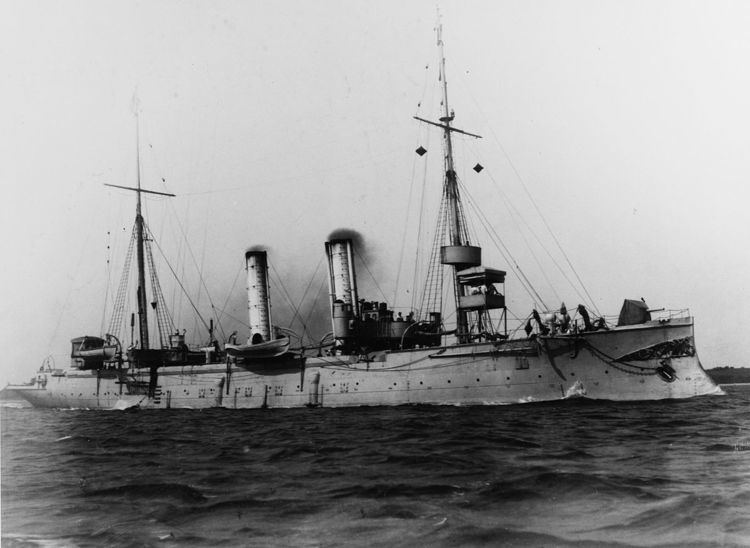Operators Kaiserliche Marine Succeeded by SMS Greif In service 1883–1922 | Preceded by SMS Zieten Built 1881–84 Completed 2 | |
 | ||
The Blitz class was a pair of avisos built by the Imperial German Navy (Kaiserliche Marine) in the 1880s. The ships, Blitz and Pfeil, were the first steel-hulled ships of any kind built by the German Navy, and the progenitors of the later light cruisers of the Gazelle type. They were armed with a 12.5 cm (4.9 in) gun and one 35 cm (14 in) torpedo tube as their principal armament, and were capable of a top speed in excess of 15 knots (28 km/h; 17 mph).
Contents
Blitz and Pfeil served extensively in various roles, including as flotilla leaders for torpedo boats. Pfeil was deployed to German East Africa in 1889 to suppress an anti-colonial revolt, and after 1899, was used for fishery protection. They were both reduced to tenders by 1912. Blitz was briefly used as a coastal patrol vessel early in World War I before returning to tender duties by 1915. Both ships survived the war, and were sold for scrap in the early 1920s.
Design
The Blitz class avisos were the first step toward creating the modern, steel-hulled light cruiser, which would ultimately come to fruition in the Gazelle class, built a decade later. The Blitz-class ships were also the first steel-hulled ships of any type built by the German Navy. At the time of their completion, they were among the earliest torpedo cruisers in the world.
General characteristics
The Blitz-class ships were 75.30 meters (247 ft 1 in) long at the waterline and 78.43 m (257 ft 4 in) long overall. They had a beam of 9.90 m (32 ft 6 in) and a maximum draft of 4.07 m (13.4 ft) forward. The ships displaced 1,381 metric tons (1,359 long tons) as designed and up to 1,486 t (1,463 long tons) at full combat load. The ships' hulls were constructed with transverse and longitudinal steel frames, and contained eleven watertight compartments. A double bottom was located beneath the ships' engine rooms.
Blitz and Pfeil had a crew of 7 officers and 127 enlisted men, though this number was later revised to 6 officers and 135 sailors. When serving as torpedo boat flotilla leaders, the ships had an additional 3 officers and 16 enlisted men. The ships carried several smaller boats, including one picket boat, one yawl, and one dinghy. Later in their careers, a cutter, another yawl, and another dinghy were added.
Machinery
The ships' propulsion system consisted of two horizontal 2-cylinder double expansion engines in a single engine room. The engines drove a pair of 3-bladed screws. Steam for the engines was provided by eight coal-fired locomotive boilers. After refits in the early 1890s, the ships' boilers were replaced with newer, more efficient models; Blitz received eight transverse cylindrical boilers, while Pfeil had eight cylindrical boilers installed. The ships were supplied with electrical power with a single 10-kilowatt (13 hp) generator that operated at 67 volts. As built, the ships were fitted with a schooner rig with a sail area of 591 square meters (6,360 sq ft) to supplement her steam engines, but this was later reduced to a rig of auxiliary sails with an area of 282 m2 (3,040 sq ft), and the sails were removed entirely by 1900.
The propulsion system was rated at 2,700 indicated horsepower (2,000 kW), for a top speed of 16 knots (30 km/h; 18 mph). Neither ship reached this speed on trials; Blitz managed 15.7 knots (29.1 km/h; 18.1 mph), and Pfeil made 15.6 knots (28.9 km/h; 18.0 mph). The ships carried up to 220 t (220 long tons; 240 short tons) of coal, which allowed them to steam for approximately 2,440 nautical miles (4,520 km; 2,810 mi) at a cruising speed of 9 knots (17 km/h; 10 mph). Steering was controlled with one rudder.
Armament
As built, the Blitz-class avisos were armed with one 12.5 cm (4.9 in) K L/23 gun placed in a pivot mount. The gun was supplied with 100 rounds of ammunition. The ships were also equipped with four 8.7 cm K L/23 guns in single mounts and one 35 cm (14 in) torpedo tube mounted in the bow. In 1891 and 1892, the ships were rearmed with six 8.8 cm SK L/30 guns in single mounts and three 35 cm torpedo tubes, one in the bow and one on each broadside, all submerged in the hull. The ships did not carry any armor protection.
Service history
Blitz was laid down at the Norddeutscher Schiffbau in Kiel in 1881. She was launched on 26 August 1882 and commissioned into the German fleet on 28 March 1883. Pfeil was built by the Kaiserliche Werft shipyard in Wilhelmshaven. Her keel was laid down in 1881, she was launched on 16 September 1882, and commissioned into the German fleet on 25 November 1884. Both ships served in the fleet following their commissioning. Blitz was assigned as the flagship of the I Torpedo-boat Flotilla, while Pfeil initially served as a tender for the fleet.
Blitz participated in extensive training and experimentation in the Torpedo School, under the command of Alfred von Tirpitz, the future architect of the High Seas Fleet. In 1889, Pfeil was sent to German East Africa to participate in the suppression of a local revolt against German colonial rule. By 1899, both ships were withdrawn from front line service; Pfeil was used for fishery protection, and Blitz became a fleet tender. In 1912, both Blitz and Pfeil were serving as tenders to the I Battle Squadron and the II Battle Squadron, respectively. At the outbreak of World War I in August 1914, Blitz was mobilized as a coastal patrol ship, while Pfeil remained a tender. Blitz returned to her tender duties in 1915. Both ships were sold for scrapping in the early 1920s.
